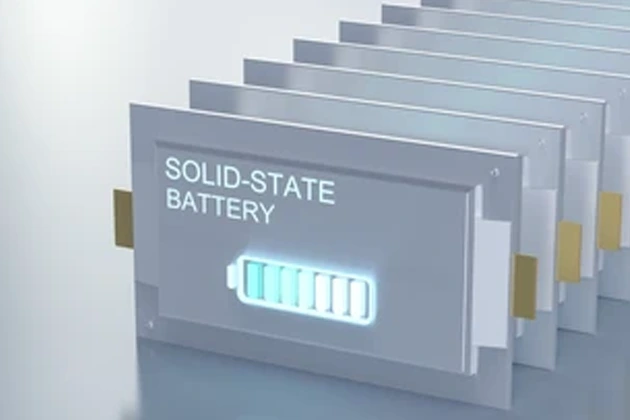Solid-state battery technology is a revolutionary technology that aims to provide high specific energy and high energy density. This groundbreaking technology has the potential to improve energy density, battery sustainability, and safety all in a single battery. With the advent of electronic vehicles and energy storage systems, the solid-state battery has been launched to improve performance and thermal stability. Read ahead to learn more about this technology and its advantages and challenges.
Divulging Solid-State Battery Technology
The constraints of corrosion, solvent consumption, and passivation in Liquid-state batteries inspired the idea of developing solid-state battery technology. Solid-state battery (SSB) dispenses with liquid electrolytes and avoids gassing or liquid leakage. These batteries require solid electrolytes that are yet to be found in conductivities comparable to aqueous solutions. The solid-state electrolytes (SEs) in solid-state battery technology offer more safety compared to the existing liquid Li-ion technology.
One of the most promising applications of solid-state Ionics is a solid-state battery that provides high energy or high-power density energy storage with amplified safety and temperature stability. Solid electrolytes are the only components that help in identifying solid-state batteries and SEs with good conductivity of ions.
Technologies Underpinning Solid-State Battery
The designing of solid-state batteries underlies various technologies, solid electrolytes, and electrodes being the two major tech components. Below are the underlying technologies of solid-state batteries:
- Solid Electrolytes: Solid electrolytes are composed of ceramics, polymers, or other materials, enabling ions’ movement between anode and cathode.
- Solid electrodes: These electrodes are predominantly made of lithium metal.
- Ionic conductivity: Electrolytes must have high ionic conductivity at room temperature.
- Interface stability: The interface between electrolytes and electrodes should be stable with low resistance.
Characteristics of Solid-State Batteries
Solid-state battery technology has transformed the electronic vehicle and energy storage industries, with batteries having multiple features. Here are some characteristics of a solid-state battery-
1) Non-flammability: The solid electrolytes in these batteries are non-inflammable. It offers solutions to safety concerns and environmental compatibility.
2) Longevity: Solid-state batteries last longer compared to liquid-state ones as they undergo less tear and wear during operation. They are shock and vibration-proof and can operate within temperatures up to 200 ° Celsius.
3) Safety and High energy density: This battery type provides safety, achievable energy density, and longevity. The solid electrolytes simplify cell structure and remove restrictions in terms of architecture and safety.
4) Flexibility and lightweight: The solid-state battery technology makes sure batteries are flexible and lightweight, making them suitable for electric vehicles, medical devices, and military facilities.
Advantages
Solid-state batteries are considered more effective than lithium-ion alternatives. Below are key advantages offered by solid-state batteries across various applications.
-
Improved Energy Density
Thanks to solid-state battery technology, the production of lithium batteries has been revolutionized with solid-state batteries. A solid-state battery has a high energy density that allows more energy storage per unit volume or weight.
-
Faster Charging
Compared to lithium-ion batteries that take up to 12 hours to charge, solid-state batteries can take a maximum of 15 minutes to complete 80% charge. These batteries can be charged 5 times more than lithium-ion batteries throughout their lifecycle.
-
Increased Safety and Thermal Stability
The solid electrolytes are non-inflammable, which increases safety. The chemically and thermally stable electrolytes increase the thermal stability of these batteries.
-
Reduced Risk of Leakage or Explosion
Unlike liquid-state batteries, a solid-state battery relies on solid electrolytes. This prevents leakage of liquid components and chances of explosion.
-
Expanded Temperature
Solid-state batteries are temperature tolerant. They can work at extreme temperatures and also avoid overheating.
-
Longer Lifecycle
As this battery type has a higher energy density, they are likely to have a longer battery life. Their longer lifecycle withstands charging cycles without degrading the lifespan.
-
Enhanced Performance
With faster charging, expanded temperature, high energy density, and reduced leakage, the solid-state battery technology enhances the performance of devices using this battery type.
-
Lowered Cost
A solid-state battery has a comparatively lower cost than a lithium-ion battery as it eliminates anode host material and reduces manufacturing costs.
-
Lower Carbon Footprint
As it requires fewer materials at the time of manufacturing, a solid-state battery reduces environmental impact significantly.
Disadvantages
Despite a wide range of benefits, solid-state battery technology has many disadvantages as well.
- A solid-state battery is not suitable for use in low and ambient temperature conditions. This is because solid oxide has a large resistance at room temperature to ionic conductivity.
- The power and current output are less for solid-state batteries.
- The stress developed at the electrode-electrolyte interface reduces battery longevity due to continuous contact with the solid electrolyte.
Examples of Solid-State Battery Application
Solid-state batteries are applied on a range of devices. Let’s have a look.
- Electric vehicles: In EVs, solid-state batteries help improve safety, charging, and power range. EVs by Toyota, Volkswagen, MG, and Nissan have used this battery.
- Electronic products: Smartphones and laptops have solid-state batteries.
- Renewable energy storage: They are also used in grid storage systems that store energy from renewable sources like solar power and wind.
- Apart from these, solid-state battery technology is also applied to aircraft, medical devices, drones, RFIDs, and others.
Conclusion
A solid-state battery faces challenges in implementation and scale-up. However, this battery design intends to take a step further in devising a more efficient and advanced battery using a “pouch cell” design. With advancements in solid-state technology, we are yet to witness the unformidable power of solid-state batteries in the near future.










